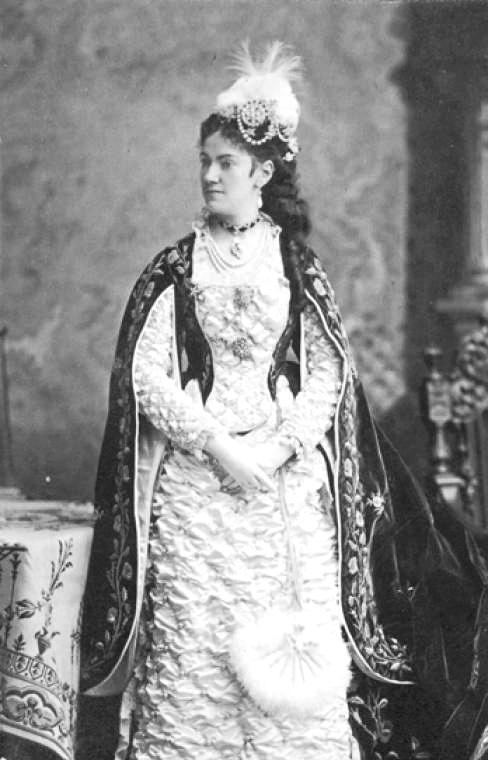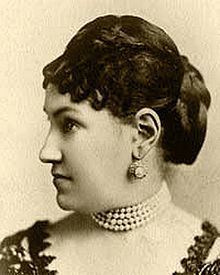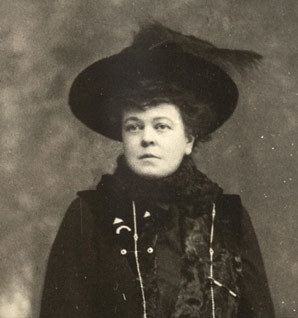 | ||
Full Name Caroline Webster Schermerhorn Known for self-proclaimed The Mrs. Astor, matriarch of male line of American Astors Died 30 October 1908, New York City, New York, United States Spouse William Backhouse Astor Jr. (m. 1854) Children John Jacob Astor IV, Helen Astor Roosevelt Parents Abraham Schermerhorn, Helen White Schermerhorn Grandchildren Vincent Astor, Ava Alice Muriel Astor, John Jacob Astor VI, Tadd Roosevelt, Helen Roosevelt Robinson Similar John Jacob Astor IV, William Backhouse Astor Jr, Madeleine Astor, Vincent Astor, William Backhouse Astor Sr | ||
Caroline Webster "Lina" Schermerhorn (September 21, 1830 – October 30, 1908) was a prominent American socialite of the last quarter of the 19th century. Famous for being referred to later in life as "the Mrs. Astor" or simply "Mrs. Astor", she was the wife of businessman, racehorse breeder/owner, and yachtsman William Backhouse Astor Jr. (1829–1892). Their son, Colonel John Jacob Astor IV, perished on the RMS Titanic. Through her marriage, she was a prominent member of the Astor family and matriarch of the male line of American Astors.
Contents
- Childhood and youth
- Marriage and family
- Socialite
- The gatekeeper
- Relationship with the Vanderbilts
- Use of Mrs Astor
- Waldorf Astoria Hotel
- Death grave and legacy
- References

Childhood and youth
Lina was born on September 21, 1830 into New York City's Dutch aristocracy, descendants of the city's original settlers. Her father, Abraham Schermerhorn (1783–1850), and the extended Schermerhorn family were engaged in shipping. At the time of Lina's birth, Abraham was worth half a million dollars. Her mother was Helen White (1792–1881). Lina was the couple's ninth child.
At the time of her birth, her family lived at 1 Greenwich Street, near the Bowling Green, but the population growth and increasing urbanization of lower Manhattan in the 1830s led her family to move farther north to 36 Bond Street, near the then-ultra fashionable "Lafayette Place," which had been developed by her future husband's paternal grandfather, fur-trader John Jacob Astor.

Young Lina was educated at a school run by Mrs. Bensee, a French emigree. There she learned to speak French fluently.
Marriage and family

On September 23, 1853, she married William Backhouse Astor Jr. (1829–1892) at Trinity Church. Her husband was the middle son of real estate businessman William Backhouse Astor Sr. (1792–1875) and Margaret Alida Rebecca Armstrong (1800–1872). His paternal grandfather was John Jacob Astor (1763–1848) and his maternal grandparents were Senator John Armstrong Jr. (1758–1843) and Alida Livingston (1761–1822), daughter of Robert Livingston of the Livingston family.
Despite the wealth of the Astor family, Lina had the superior pedigree as a member of an old Knickerbocker family. Together, they had five children:
- Emily Astor (1854–1881), who married James John Van Alen (1848–1923), a sportsman/politician, and had three children
- Helen Schermerhorn Astor (1855–1893), who married James Roosevelt "Rosey" Roosevelt (1854–1927), a diplomat and the elder half-brother of future President Franklin Delano Roosevelt, and had two children
- Charlotte Augusta Astor (1858–1920), who married James Coleman Drayton and had four children. She later married George Ogilvy Haig
- Caroline Schermerhorn "Carrie" Astor (1861–1948), who married Marshall Orme Wilson, the brother of banker Richard Thornton Wilson, Jr. and socialite Grace Graham Wilson, in 1884 and had two sons
- John Jacob "Jack" Astor IV (1864–1912), who married Ava Lowle Willing (1868–1958), a socialite, and had two children, later married socialite Madeleine Talmage Force (1893–1940), sister of real estate businesswoman/socialite Katherine Emmons Force, and had one son
Socialite
Although popularly imagined as wholly preoccupied with "Society", for the first several decades of her married life, Lina Astor was principally occupied with raising her five children and running her household, as was typical of women of her class in mid-19th-century New York City. However, due to an inheritance from her parents, Lina had her own money and she was far less dependent on her husband than most Americans of the time.
In 1862, she and her husband built a four-bay townhouse in the newly fashionable brownstone style at 350 Fifth Avenue, the present site of the Empire State Building, next door to her husband's older brother, John Jacob Astor III; the two families were next-door neighbors for 28 years although the Astor brothers did not get along. The Astors also maintained a "summer cottage" in Newport, Rhode Island, a mansion called Beechwood, which had a ballroom grand enough to fit "The 400" - the most fashionable socialites of the day.
The gatekeeper
In the decades following the Civil War the population of New York City grew almost exponentially, and immigrants and wealthy arrivistes from the Midwest began challenging the dominance of the old New York Establishment. Aided by the social arbiter Ward McAllister, Lina attempted to codify proper behavior and etiquette, as well as determine who was acceptable among the arrivistes for an increasingly heterogeneous city. They were the champions of old money and tradition.
McAllister once stated that, amongst the vastly rich families of Gilded Age New York, there were only 400 people who could be counted as members of Fashionable Society. He did not, as is commonly written, arrive at this number based on the limitations of Mrs. Astor's New York City ballroom. (McAllister, an Astor cousin by marriage, referred to her as the "Mystic Rose".) Her husband's lack of interest in the social whirl did not stop but instead fueled her burgeoning social activities, which increased in intensity as her children grew older.
Lina was the foremost authority on the "Aristocracy" of New York in the late nineteenth century. She held ornate and elaborate parties for herself and other members of the elite New York socialite crowd. None was permitted to attend these gatherings without an official calling card from her. Lina's social groups were dominated by strong-willed "aristocratic" females. These social gatherings were dependent on overly conspicuous luxury and publicity. More so than the gatherings themselves, importance was highly placed upon the group as the upper-crust of New York's elite. She and her ladies therefore represented the "Aristocratic", or the Old Money, whereas the newly wealthy Vanderbilt family would establish a new wave of New Money.
Relationship with the Vanderbilts
The Vanderbilts, as members of socialite New York through the copious amounts of money that the family had earned rather than inherited, represented a type of wealth that was abhorrent to Astor and her group. The Mrs. Astor found railroad money distasteful. For this reason, Astor was reluctant to call upon the Vanderbilt girls. In 1883, however, Astor was forced to formally acknowledge the wealthy socialite Alva Erskine Smith, first wife of horse breeder/railroad manager William Kissam Vanderbilt, thereby providing the Vanderbilts, the greatest "new" fortune in New York, entrance into the highest rungs of society.
An oft-repeated New York legend has it that Alva Vanderbilt had planned an elaborate costume ball with entertainments given by young society figures for her housewarming, but at the last minute notified young Caroline Astor (Lina's youngest daughter) that she could not participate, because Astor had never formally called on Vanderbilt. Also likely, Astor had noted the rising social profile of the Vanderbilt family, led by Alva and Willie, and viewing them as useful allies in her efforts to keep New York society exclusive had called formally on the Vanderbilts prior to Alva's lavish ball which Astor herself attended. The Vanderbilts were subsequently invited to Astor's annual ball, a formal acknowledgement of their full acceptance into the upper echelon of New York society.
Use of "Mrs. Astor"
Until 1887, Lina Astor had been formally known as "Mrs. William Astor", but with Charlotte Augusta Gibbes' death that year, she shortened her formal title to "Mrs. Astor", as she was then the senior Mrs. Astor, the only remaining one in her generation. Charlotte's son, William Waldorf Astor, felt that his own wife, Mary "Mamie" Dahlgren Paul, should be "the Mrs. Astor." With the death of John Jacob Astor III in 1890, William Waldorf Astor had inherited his father's share of the Astor holdings and, titularly, became the head of the Astor family. In his mind, this made Mamie "The Mrs. Astor." However, Mamie was eighteen years younger than Lina and lacked Lina's social power.
His further attempts at challenging Lina's preeminence in New York society, however, were thwarted, and he soon moved with his family to England, where he later became a viscount.
Waldorf-Astoria Hotel
In retaliation for his aunt's intransigence, William Waldorf Astor had his father's house torn down and replaced by the first Waldorf Hotel. The hotel was specifically designed to overshadow Mrs. Astor's mansion, which was right next door, in an attempt to overshadow her status with it. The Waldorf Hotel was thirteen stories tall and was built in the form of a German Renaissance chateau: it thus not only overshadowed Lina, but all other structures in the neighborhood as well. Mrs. Astor famously stated about the hotel, "There's a glorified tavern next door."
Until the opulence of the Waldorf Hotel revolutionized how New York socialized publicly, polite society did not gather in public places, especially hotels. Unwilling to live next door to New York's latest sensation and public draw, she and her son, Jack, first contemplated tearing down her house and replacing it with livery stables. Eventually she and Jack tore down their house and erected another hotel at its site, the Astoria, and soon the two hotels merged and became the original Waldorf-Astoria Hotel, which was torn down in 1928 to make way for the Empire State Building.
Death, grave, and legacy
By the time she moved into her new house facing Central Park, at the corner of 65th Street, her husband had died, and she lived with her son and his family. Astor spent her last several years suffering from periodic dementia, and she died at age 78 on October 30, 1908, and was interred in the Trinity Church Cemetery located in the northern section of Manhattan.
Her youngest daughter, Carrie, erected a commemorative 39 foot tall (11.9 m) cenotaph in her memory, in addition to her uptown burial plot. The inscription is dated A.D. MDMXIV and the cenotaph is located within the small churchyard cemetery at the intersection of Broadway and Wall Street, in which many prominent early Americans are buried.
Following The Mrs. Astor's death, it reportedly took three women to fill her role in New York Society:
